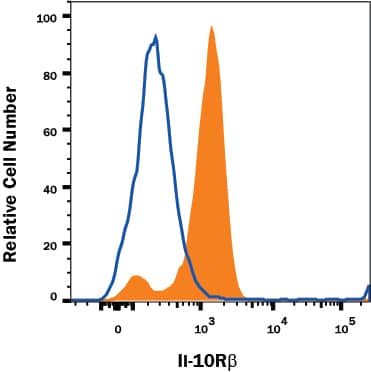Human IL-10 R beta Antibody
R&D Systems, part of Bio-Techne | Catalog # MAB874


Key Product Details
Species Reactivity
Validated:
Cited:
Applications
Validated:
Cited:
Label
Antibody Source
Product Specifications
Immunogen
Met20-Ser220
Accession # Q08334
Specificity
Clonality
Host
Isotype
Endotoxin Level
Scientific Data Images for Human IL-10 R beta Antibody
IL‑10 Inhibition of IL‑1 beta secre-tion and Neutralization by Human IL‑10 R beta Antibody.
Recombinant Human IL-10 (Catalog # 217-IL) inhibits IL-1 beta secretion in LPS-activated human peripheral blood mononuclear cells (PBMC) in a dose-dependent manner (orange line), as measured by the Human IL-1 beta/IL-1F2 Quantikine ELISA Kit (Catalog # DLB50). IL-1 beta secre-tion inhibited by Recombinant Human IL-10 (0.25 ng/mL) is neutralized (green line) by increasing concentrations of Mouse Anti-Human IL-10 R beta Monoclonal Antibody (Catalog # MAB874). The ND50 is typically 0.5-2 µg/mL in the presence of LPS (0.25 ng/mL).Detection of IL‑10 R beta in Human PBMC Monocytes by Flow Cytometry
Human PBMC monocytes were stained with Mouse Anti-Human IL-10 R beta Monoclonal Antibody (Catalog # MAB874, filled histogram) or isotype control antibody (Catalog # MAB002, open histogram) followed by PE-conjugated Anti-Mouse IgG Secondary Antibody (Catalog # F0102B). View our protocol for Staining Membrane-associated Proteins.Applications for Human IL-10 R beta Antibody
CyTOF-ready
Flow Cytometry
Sample: Human PBMC monocytes
Western Blot
Sample: Recombinant Human IL-10 R beta Fc Chimera (Catalog # 874-RB)
Neutralization
Reviewed Applications
Read 1 review rated 3 using MAB874 in the following applications:
Formulation, Preparation, and Storage
Purification
Reconstitution
Formulation
Shipping
Stability & Storage
- 12 months from date of receipt, -20 to -70 °C as supplied.
- 1 month, 2 to 8 °C under sterile conditions after reconstitution.
- 6 months, -20 to -70 °C under sterile conditions after reconstitution.
Background: IL-10 R beta
IL-10 R beta, also known as IL-10 R2, mediates its biological activities via binding to a heteromeric receptor complex consisting of two distinct type II cytokine receptor subunits, the ligand binding IL-10 R alpha and the IL-10 R beta which does not bind IL-10 by itself but is required for signal transduction. The cDNA for human IL-10 R beta encodes a 325 amino acid (aa) type I transmembrane precursor protein with a 20 aa signal sequence, a 200 aa extracellular region, a 29 aa transmembrane segment and a 76 aa cytoplasmic domain. Within the extracellular region, there are two 100 aa subdomains that resemble the constant region of immunoglobulins. This structural motif is responsible for the alternative designation of IL-10 R beta as CRF2-4 (the 4th member of the cytokine receptor family class II/2). Human and mouse IL-10 R beta share approximately 69% aa sequence identity. Binding of the non-covalent IL-10 dimer to two IL-10 R alpha chains recruits two IL‑10 R beta chains resulting in the activation and phosphorylation of the signaling cascade involving JAK1, TYK2, and STAT3. IL-10 R beta is expressed ubiquitously. IL‑10 R beta is also a component of the IL-22 receptor complex consisting of the IL-10 R beta chain and IL-22 R, another type II cytokine receptor family member.
References
- Donnelly, R.P. et al. (2004) J. Leukoc. Biol. 76:314.
- Donnelly, R.P. et al. (1999) J. Interferon Cytokine Res. 19:563.
- Kotenko, S.V. et al. (2000) J. Biol. Chem. 276:2725.
- Liu, Y. et al. (1994) J. Immunol. 152:1821.
- Lutfalla, G. et al. (1993) Genomics 16:366.
- Kotenko, S.V. et al. (1997) EMBO J. 16:5894.
Long Name
Alternate Names
Gene Symbol
UniProt
Additional IL-10 R beta Products
Product Documents for Human IL-10 R beta Antibody
Product Specific Notices for Human IL-10 R beta Antibody
For research use only
